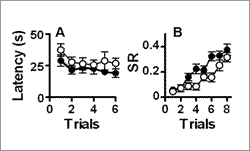Print version
Search Pub Med
Impairments in working memory and fear extinction in mice lacking the metabotropic glutamate receptor subtype 7 Metabotropic glutamate receptors subtype 7 (mGluR7) are expressed in areas vital for learning and memory, such as the frontal cortex and hippocampus (Kinzie et al., 1995). Accordingly, mice lacking the receptor seem selectively impaired in certain aspects of memory (Holscher et al., 2004). Extinction of conditioned fear responses is considered to be an active and context-dependent form of learning that inhibits the expression of a conditioned response (Bouton, 2002; Rescorla, 1996), and may thus critically depend on higher-level cognitive processes. We have therefore examined the performance of mGluR7 deficient mice in spatial working memory tasks as well as in a conditioned emotional response (CER; Davis, 1990) procedure. Mice (20-25g), mixed gender, N=15 (mGluR7 -/ -) and 11 ( +/ +), were tested in the hidden-platform Morris water maze. After establishing a stable acquisition curve and a clear preference for the target quadrant, spatial working memory abilities were assessed. Platform location was changed between each trial block (5 swims of 2 min/day). The first swim served as a cue trial, during the following 4 swimming trials escape latency was averaged. Next, mice were trained during daily 30-min sessions to obtain food pellets by nose poking. After establishing a stable response rate in a variable interval (VI-30s) schedule, 8 superimposed tone-shock CER sessions (fear acquisition) suppression of these operant responses was used as a measure for conditioned fear. Fear extinction was examined during 8 subsequent extinction sessions (tone alone). Rate of nose poking during the tones (a) was compared to rate of nose poking in the absence of the tones (b) by calculating suppression ratios SR= a / (a + b).
The deficit observed in mGluR7 knockout mice in fear extinction and spatial working memory capability may relate to the brain structures putatively underlying extinction as well as working memory processes that contribute to memory consolidation (Ranganath et al., 2005). B outon, ME (2002). Biol Psychiatry, 52, 976-86. |


